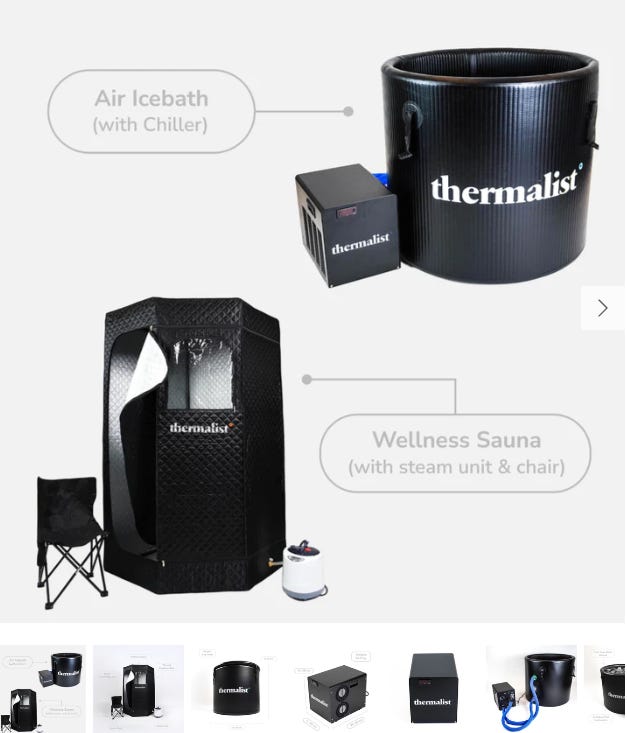When a Body Is the Billboard: On Headless Women, Weight-Loss Ads, and the Vanishing of Agency
What a Danish ad from Novo Nordisk reveals about how women’s bodies are still treated as objects to be “fixed.”
There’s a poster on a Danish train platform that won’t leave my mind. It shows a woman’s body—no head—paired with a message linking menopause and weight. It’s part of a Novo Nordisk campaign in Denmark. Whether you encountered it at Humlebæk (as several posts document) or heard about it elsewhere, the image is unmistakable: a torso becomes the message. And when the body is the message, the person often disappears.
I’m adding my voice to a debate already in motion. In Denmark, marketers, clinicians, and ordinary commuters are arguing over whether this campaign is helpful public health or covert pharma marketing; whether it informs, stigmatizes, or quietly shifts the line between “normal” and “needs medical treatment.” It’s heated—and it should be. The headless woman is not a neutral aesthetic choice; it’s a signal about who gets to have a mind, a voice, a will, when we talk about women’s bodies and weight.
Translation of the poster from Danish to English:
“Hard to maintain weight during menopause?
You are not alone.”
“8 out of 10 Danish women experience that, with age, it becomes harder to maintain their weight.
This is due to hormonal changes in the body – not you.”
“Talk to your doctor about whether weight-loss treatment is relevant for you.”
🎁Christmas Sale on Products - until 22. December 2025!
Lowest prices in Europe!
See the bottom of this post…
What the image says
When you remove a head, you remove a face, a gaze, the possibility of speech. You reduce a subject to an object. This is not just theory—it’s a visual grammar we’ve seen for decades. The “headless women” motif in posters and ads fragments women into consumable parts. It tells viewers: look at the body, not to the person. In a weight-loss context, that framing matters, because the story easily collapses into: “This body is a problem to be solved.”
Now add menopause. Yes, menopause can be metabolically challenging. Yes, some people seek medical help. But the poster’s choice to decapitate the woman’s image—exactly when the copy invites medicalized “management” of her weight—turns a complex life stage into a simple visual command: fix the body. Where, in that image, do we locate judgment, ambivalence, consent, and personal goals? Where do we locate will?
“It’s highly debated” isn’t a disclaimer—it’s the point
In Danish coverage and commentary, you’ll find pushback from public-health voices, legal takes about “hidden” advertising, and a counter-chorus insisting the campaign is within the rules and nudges women to see their doctor. In other words: the debate is real, live, and polarized. That polarization itself exposes the stakes: we’re not merely wrangling over compliance; we’re wrestling over cultural power—who defines women’s bodies, and on what terms.
To me, the dividing line is not whether weight-loss medicine can be appropriate. It’s that the image erases the very person who must decide. If a campaign genuinely respects women’s agency, why depict a woman stripped of the very features that signify personhood and choice?
This isn’t just Denmark. It’s everywhere.
If this poster feels familiar, that’s because it sits inside a universal pattern. The “headless woman” has been catalogued across film, fashion, and advertising—a shorthand that dehumanizes by design. Researchers and critics have documented how such imagery correlates with self-objectification and shame. You don’t need a PhD in media studies to grasp the effect; you can feel it in your body: a subtle tightening, a sense that the only “right” body is the one on the wall—silent, improved, compliant.
When a global company riding the crest of a weight-loss boom adopts this visual language, it doesn’t just sell a product; it re-teaches the lesson. The female body is a public problem. The solution is technical. The person can be cropped out.
What a respectful campaign would do
A respectful campaign doesn’t tiptoe around biology or pretend weight is never medical. But it refuses visual shortcuts that erase personhood. It shows faces. It shows dialogue. It acknowledges mixed feelings. It makes room for the possibility that not everyone wants this pathway. It invites women to define their goals, not to conform to a single body ideal in the name of “health.”
If we truly believe obesity is complex and not a failure of will, our imagery must honor will. Put the head back on. Return the gaze. Let the person speak.
My position!
I believe this ad crosses a line by picturing a woman as body-only at the precise moment it urges medical intervention. That choice undermines agency in the name of “help.” And removes the option of choice, change with lifestyle via dialogue. The public backlash isn’t overblown; it’s a rational response to a visual tradition that has long trained us to treat women’s bodies as objects first and persons second. Denmark is just the latest stage. The problem is universal.
Until campaigns stop cropping out women’s faces—and with them, their choices—we will keep having this argument. And we should.
Dr Susanna Søberg
PhD in Metabolism | Founder of the Thermalist Method®
🎁Christmas Sale on Products - until 22. December 2025!
Lowest prices in Europe!
🎀Get your Christmas presents to your door 🎀
Lowest prices in Europe!
Ice bath 30% off. Use code: CHRISTMAS30 at checkout - CLICK HERE
Steam Sauna 30% off. Use code CHRISTMAS30 at checkout - CLICK HERE
Ice bath + Sauna + online course 30% off. Use code CHRISTMAS30 at checkout- CLICK HERE
Chiller+ Ice bath 20% off. Use code CHRISTMAS20 at checkout - CLICK HERE
Chiller, ice bath + sauna + online course 20% off. Use code CHRISTMAS20 at checkout - CLICK HERE
Limited stock available. Shipping only in Europe.




